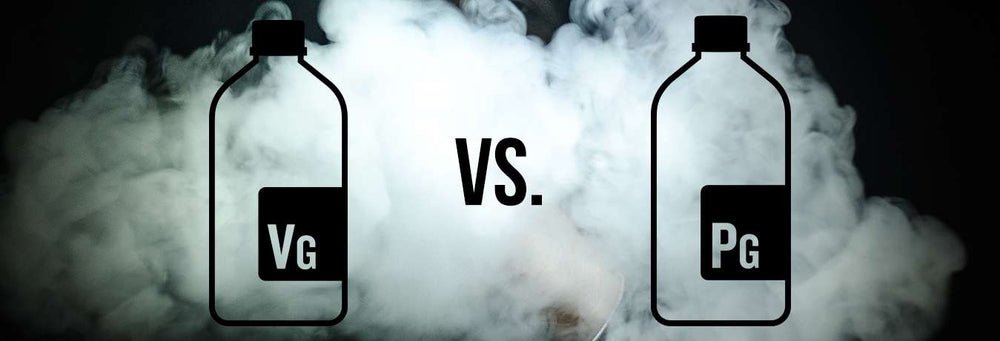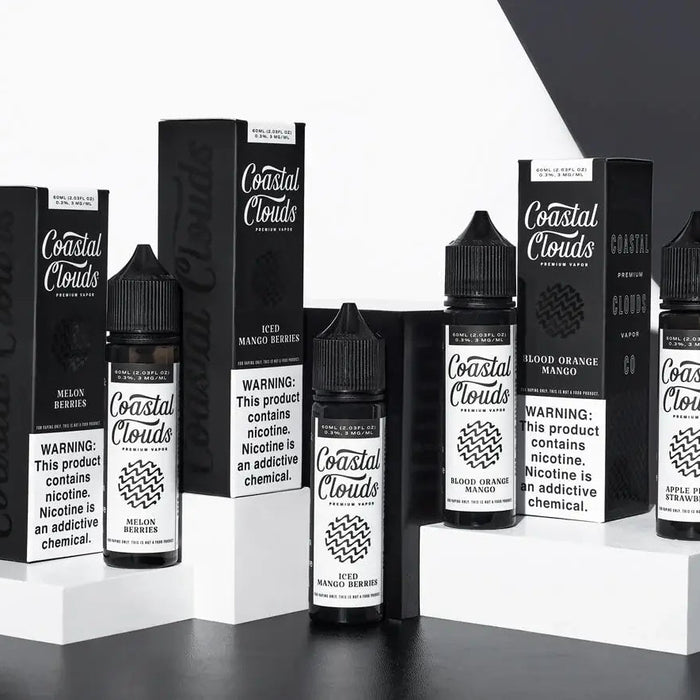How many times have you looked at the label of your favorite vape juice and really checked to see what’s inside? Sure, most of us only care about the flavor and nicotine content, but there are two very important ingredients that many vapers are already familiar with: VG (vegetable glycerin) and PG (propylene glycol). Let’s take a look at each and see what they give us
VG & PG...WHAT ARE THEY?
VG and PG are the base of your e-liquid that dictate cloud volume and e-liquid flavor. Flavor and nicotine are added to create a vapable e-liquid. But it’s the ratio of PG and VG that becomes important depending on what you’re looking to get out of your vaping experience. They’re both odorless, non-toxic, and when heated, they produce a smooth cloud of vapor that can safely be inhaled. Contrary to popular belief and despite their appearance, these two liquids are not actually oils. Both VG & PG are categorized as sugar alcohols and are actually found in various food products. Inhaling these two liquids will not cause any medical issues due to their scientific makeup, whereas inhaling actual oils can cause lipoid pneumonia. VG and PG are both slightly different in their consistencies and tastes, and offer different throat and mouth sensations as they are vaped. Now that we know what these intriguing liquids are, let’s explore a little deeper into just exactly what each of these liquids are.
PG: PROPYLENE GLYCOL
As we mentioned earlier, PG is one of the two odorless liquids that make the base of your favorite vape juice. PG, or Propylene Glycol, is colorless and odorless. It is not as viscous as VG, but it is more effective in delivering e-liquid flavor than VG. Lastly, PG is best known for delivering something called, “a throat hit,” a sensation in the back of the throat that is likened to smoking tobacco products.
USES FOR PG
PG is actually found in a variety of familiar household items. In your bathroom, PG is found in toothpaste and shampoos. In your kitchen, PG is found in several types of pet food, though oddly not in cat food. In your purse and on your nightstand, PG can be found in common beauty products like baby wipes and makeup.
With all these everyday products that have PG in their ingredient, your next question is naturally, “Is PG safe to use?” The easy and flippant answer would be, “Of course! Why would you intentionally use something that’s toxic?” But the true answer is… we really don’t know. While it’s true that many studies have proven that ingesting PG is safe (especially since it’s a food additive), there are very few studies that look at PG as an inhaled product. There is a single study in 1947 that states that the inhalation of PG is completely harmless.
SAFETY CONCERNS FOR PG
Perhaps you’ve heard horror stories that PG is found in antifreeze and therefore is dangerous to inhale. What many people don’t realize is that there are two types of antifreeze: toxic and non-toxic. Toxic antifreeze contains something called “ethylene glycol” or “EG”, which isn’t used in vape juice. Propylene glycol, or “PG,” is found in non-toxic antifreezes for machines that are used for food processing. Food processing machinery obviously can’t come into contact with toxic substances; therefore, PG is safe to ingest, although more testing is needed to find the long term effects of inhaling PG.
Earlier in this article, we mentioned that PG is found in pet food, but not in cat food. PG has actually been linked to Heinz body anemia in cats. While it’s still considered safe for humans to consume and poses no threats for dogs, try to avoid vaping high PG e-liquid around cats.
One thing to be aware of when vaping PG is that it is the main ingredient in vape juice responsible for the throat hit. Many users report high PG vape juices have caused throat irritation. While it is uncommon for users to be allergic to PG, some rare cases have been documented. If you’re starting out as a new vaper, keep an eye out for any rashes or any disconcerting reactions. However, common side effects of high PG e-liquids are sore throat, increased thirst, and dry mouth. Once your body becomes adjusted to the PG content, these symptoms should disappear. Keep in mind that these side effects could also be a reaction to your body giving up tobacco cigarettes, and not only due to the PG content.
Now that we’ve gone over what PG is, let’s check out the other half of the e-liquid base: VG!
VG: VEGETABLE GLYCERIN
VG, or vegetable glycerin, is the second part of your vape juice, usually the higher number in the ratio. VG is actually a derivative from vegetable oil, making it a natural chemical. The main point of VG is to thicken the vape juice, which is why you see full PG liquids as very watery. We mentioned earlier that both VG and PG have slight tastes to them; VG has a faintly sweet taste and gives off a smooth throat hit, more so than PG. VG is preferred for sub-ohm devices, and is available with vendors, sometimes upon request!
USES FOR VG
Just like PG, VG is found in many items you use every day. In the kitchen, VG is found in common sugar substitutes, certain sweets and baked goods (to insure freshness and adequate moisture), and various pet foods. In the bathroom, VG is in toothpastes, assorted dental items, various soaps, medicinal and hand creams, deodorants, aftershaves, bubble bath, hair mousse, and makeup! The next time you’re dabbing on some lipstick before a date or eyeing that freshly baked apple pie at the grocery store, glance through the ingredient list. You might have already been consuming VG and not even knowing it. Although VG is a big part of our daily lives, it begs the question of, “Is it safe?” Let’s take a look at what the FDA has to say about the safety concerns of VG.
SAFETY CONCERNS FOR VG
Vegetable Glycerin has been classified as “generally safe” by the FDA; as it is widely found in many of our everyday products, food and medicine alike, it’s safe to assume that the general uses of VG pose no threat to our consumption of VG. Unfortunately, just like PG, there are limited studies on the actual inhalation safety concerns. The few studies available show that the risks involved with inhaling VG are minimal, but of course, more testing would need to be done to confirm the long term health issues.
One extremely minor health concern with VG is possible allergies, but only for those allergic to coconut oil or palm oil. Diabetics are also cautioned against using high amounts of VG, as it creates issues with their metabolism. However, vape juice contains such low amounts of VG that this is generally not an issue.
We mentioned that VG is used to thicken vape juice and bring out the sweeter flavors. This usefulness comes at a cost...to your atomizers. The thickness and sweetness of some of your favorite flavors means you’ll have to change your coil more often to avoid clogging it. Some atomizers, usually older models that use smaller coils, don’t work at all with high VG levels, so it will take you a certain level of trial and error to discover which flavors and VG/PG ratios work for you.
Lastly, VG has a side effect of causing dehydration. You’ll want to increase your water intake to avoid getting sore throats, increased thirst, and dry mouth. Monitor your body’s reaction to VG and abstain from vaping if you feel you need a break.
VG/PG RATIO PREFERENCES
One of the most common questions beginner vapers ask is, “which vape juice should I use?” Everyone wants huge puffy clouds, sweet pure flavor, and long-lasting coils, but it’s impossible to give an answer that suits everyone. Imagine your answer if someone asked you which fruit tastes the best, or what’s the best meat to use for a barbecue. Your answer would suit your tastes, but won’t reflect everyone else's preferences. The best way to determine your VG/PG ratio is first determine what you’re looking to get out of your vaping experience.
Throat Hit: If you’re wanting a satisfying kick to the back of your throat, similar to cigarettes, higher PG ratios are preferred. Well-mixed nicotine and high PG vape juices offer a stronger throat hit and are recommended for ex-smokers or smokers looking to wean themselves off cigarettes.
Cloudchasing: By far one of my favorite experiences of vaping, cloud chasing is the production of huge puffy clouds that completely engulf the vaper. There are competitions on who can blow the biggest cloud, and puffy clouds are so fun to intertwine your finger through. If this sounds like what you want, choose a higher VG option.
Stealth Vaping: Have you ever been to a concert and have seen a thin wisp of smoke but knew from the smell that it was vape clouds? Or if you crave a quick hit of your vape pen but don’t want to be seen doing it? High PG is your answer. Many public places frown on, if not downright forbid, vaping in the vicinity of a crowd. Amusement parks, airports, subways, beaches, and many other places have designated places where you can vape. However, not everyone wants a huge cloud of vapor blown in their face, so if you’re looking for a more discreet way to vape, check out vape juices with a lower VG ratio.
Smoothness: If you’re looking for a smooth flavor of vape juice with high flavor, check out a higher VG vape juice. Many times, VG brings a thicker cloud to your palate, but can take away from the flavor of the vape juice. Ths can usually be solved by increasing your wattage, but be careful not to burn your coil! Dry hits and damaged tanks are not fun to replace, especially when you’ve just discovered a delicious flavor with your preferred wattage.
Homemade vape juice: Try crafting your own vape juice to see what VG/PG ratio is best for you. Oftentimes, the longer a juice is left to steep, the stronger the flavor is, especially with a higher VG ratio. Many flavorings also cater to PG bases, so experiment with multiple flavors and single flavors. And finally, you can always use a straight VG/PG base with no flavoring to see what you prefer as far as cloud sensations. If your vape juice seems too thick, you can add a slight bit of water, about 10mL or so. Be careful with this, as too much water can ruin your coil and make your e-juice unusable.
CONCLUSION
And that’s it! Propylene Glycol and Vegetable Glycerin might seem like intimidating ingredients, but hopefully this article has helped you understand the functionality of both. Every vaper is different and is looking for several things to get out of the daily vaping experience. 70/30 VG/PG is definitely one of the most common ratios, but you can shop around to find 50/50, 60/40, or even full VG or PG e-liquids. One fascinating thing to know about vaping ratios is that different levels of VG and PG can enhance certain flavors. High PG ratios are good for fruits, beverages (coffee, tea, milk, etc.), and tobacco e-liquids. High VG ratios are good for custard, creamy, and other dessert flavors, since the thickness of the cloud mimics the in-mouth feel of the real dessert. Whatever your preferences are, don’t be afraid to experiment with different ratios and flavors. Try your hand at making homemade vape juices, sample different e-liquids in vape juices, or check out our grab bag item, where we send a mystery bottle of e-juice to you! Who knows, you might just discover your new favorite all-day vape juice when you’re least expecting it!




